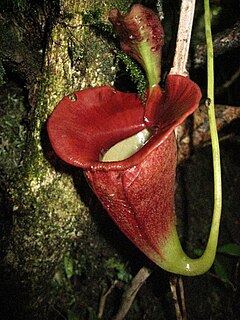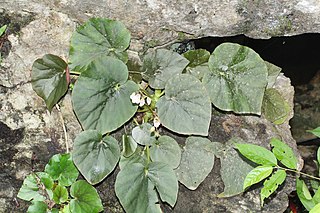
Nepenthes sibuyanensis is a tropical pitcher plant endemic to Sibuyan Island in the Philippines, after which it is named.

Nepenthes hispida is a tropical pitcher plant species native to Borneo. It grows at elevations of 100 to 800 m in kerangas forest. It is known with certainty only from Lambir Hills National Park and surrounding areas.

Nepenthes jacquelineae is a tropical pitcher plant endemic to Sumatra. Due to its unique pitcher morphology, it is considered to be one of the most spectacular Nepenthes species native to the island.

Nepenthes insignis is a tropical pitcher plant endemic to New Guinea and surrounding islands. The specific epithet insignis is Latin for "distinguished" or "remarkable".

Nepenthes mantalingajanensis is a tropical pitcher plant known only from the summit region of Mount Mantalingajan, the highest point on the Philippine island of Palawan, after which it is named.

Nepenthes peltata is a tropical pitcher plant known only from the upper slopes of Mount Hamiguitan on the island of Mindanao in the Philippines. It is characterised by a peltate tendril attachment and conspicuous indumentum. The species typically produces ovoid pitchers with a prominent basal crest and large nectar glands on the lower surface of the lid.

Nepenthes micramphora is a tropical pitcher plant known only from Mount Hamiguitan on the island of Mindanao in the Philippines. It is a highland plant growing at elevations of 1100–1635 m.

Hypericum mutilum is a species of St. John's wort known by the common name dwarf St. John's wort. It is native to parts of North America and is present in other parts as an introduced species. It is an annual or perennial herb taking a multibranched erect form up to about 60 centimeters tall. The oval green leaves are one or two centimeters long and are covered in tiny glands. The inflorescence is a compound cyme of tiny flowers. H. mutilum subsp. mutilum and subsp. boreale have a diploid number of 16, and H. mutilum subsp. boreale can have a diploid number of 18.

Nepenthes andamana is a tropical pitcher plant endemic to Phang Nga Province, Thailand, where it grows near sea level in coastal savannah and grassland. It is thought to be most closely related to N. suratensis.

Brunfelsia latifolia, commonly known as yesterday-today-tomorrow and kiss me quick, is a species of flowering plant in the nightshade family. Endemic to Brazil, it is an evergreen shrub that becomes semi-deciduous in cooler areas and grows up to 1.8 meters in height.

Nepenthes gantungensis is a tropical pitcher plant known from a single peak on the Philippine island of Palawan, where it grows at elevations of 1600–1784 m above sea level.

Nepenthes leonardoi is a tropical pitcher plant known from a single locality in central Palawan, the Philippines. It is closely allied to several other Palawan endemics, including N. deaniana, N. gantungensis, and N. mira. The traps of this species reach at least 24 cm in height. Some specimens are noted for producing very dark, almost black, upper pitchers.

Boerhavia erecta, commonly known as the erect spiderling or the erect boerhavia, is one of more than 100 species in the genus Boerhavia L. Boerhavia erecta is native to the United States, Mexico, Central America and western South America, but now is cosmopolitan in tropical and subtropical regions. In Africa its distribution extends from West Africa, eastwards to Somalia and down to South Africa. It has recently been found in parts of Madagascar and Réunion. In Asia, it occurs in India, Java, Malaysia, the Philippines, China and the Ryukyu Islands.

Nepenthes abgracilis is a tropical pitcher plant native to the Philippines. It is known only from northeastern Mindanao, including Mount Legaspi. Little is known about the altitudinal distribution of this species, but the holotype was collected at 670 m.
Hypericum cuisinii is a perennial herb in the genus Hypericum, in the section Adenosepalum. The herb has pale yellow flowers and occurs in Greece and Turkey.

Begonia elnidoensis is an endemic species of Begonia discovered in El Nido, Palawan, Philippines. The species was compared to Begonia wadei, in that both species have thick-trunked stem, differing in the widely to very widely ovate or subtriangular leaves, with the latter having obliquely ovate leaves, 3-4 secondary leaf veins where the latter has 6 on each side of the midrib, with glabrous petioles compared to latter having puberulous to tomentose, an inflorescence measuring 20–40 cm in length compared to only 6–20 cm, and the differently-sized bracts and capsules.
Begonia gironellae is an endemic species of Begonia discovered in Tanabag, Puerto Princesa, in northern Palawan, Philippines. The species resembled Begonia cleopatrae, in that both species have widely ovate, variegated leaves, and fleshy hairs fused into a ring at the base of the leaf petiole. However, Begonia gironellae differed from B. cleopatrae due to its rosette habit with rhizome shorter to 5 cm long, with very congested internodes, widely triangular stipules, differently-sized lamina and bracts, and capsule with wider abaxial wing. Additionally, B. gironellae is a lowland species occurring in broadleaved seaside forests, while B. cleopatrae grows on hill forest at ca. 400m.
Begonia quinquealata is an endemic species of Begonia discovered in Salakot Falls, Napsan, Puerto Princesa City, in northern Palawan, Philippines. This species, along with B. suborbiculata Merr., are the only two known species in the Philippines with 5-winged capsules. Unlike any other member of Begonia sect. Baryandra, B. quinquealata is very distinctive for being a densely hairy herb with long creeping rhizomes. It differs also from B. suborbiculata in that it has thickly chartaceous, widely ovate leaves that have uniformly green upper leaf surface, densely velutinous, with denticulate leaf margin, outer tepals, and red scabrous ovary and capsules.
Begonia tabonensis is an endemic species of Begonia discovered in Tabon Cave, Lipuun Point, Municipality of Quezo, in Palawan, Philippines. This species resembles B. mindorensis Merr., widely ovate and uniformly green leaves, and inflorescence with sessile glands. However the two species differs on several characteristics: Begonia tabonensis have shorter petioles(10 cm long), smaller leaves(4-8 x 4–6.4 cm); deciduous, chartaceous, glabrous or very sparsely glandular bracts; and slightly pointed, crescent-shaped ovary wing; whereas, B. mindorensis have longer petioles(25 cm long), larger leaves(10-15 x 6-10 cm); persistent, coriaceous, densely glandular bracts; and acute, triangular ovary wing.
Salix eriostachya is a species from the genus of willows (Salix) and grows as a shrub. The leaf blades are 4 to 11 centimeters long. The natural range of the species is in India, Nepal, and China.














